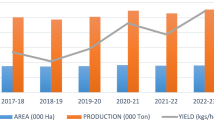Abstract
Ten seedlings from 36 crosses representing eastern and western North American short day and remontant genotypes were evaluated in 2011 and 2012 in California, Michigan, New Hampshire and Oregon, for phenology, flower related traits, plant characteristics, fruit characteristics and fruit chemistry traits. There was significant variability among genotypes, locations and evaluation year for most of the characteristics; however, few genotype × location and genotype × year interactions were detected. General combining ability variance components were significant for all traits and greater than SCA variance components for peduncle length, total flowering weeks, flowering cycles, truss size, growing degree days for harvest data, remontancy, achene position, ease of capping, fruit weight, percent soluble solids, titratable acidity and soluble solids/titratable acidity. ‘Sarian’ was identified as the best contributing parent for remontancy. Narrow-sense heritability estimates were moderate to high (0.33–0.78) for total flowering weeks, flowering cycle, truss size, remontancy, number of runners, fruit weight, pH, and titratable acidity. Having a better understanding of these attributes will provide breeders guidance on the most effective breeding strategies for incorporating superior traits from this germplasm into their programs.
Similar content being viewed by others
References
Bentvelsen G, Bouw B (2006) Breeding ornamental strawberries. Acta Hort 708:455–458
Bernardo R (2010) Estimating genetic variances. In: Bernardo J (ed) Breeding for quantitative traits in plants. Stemma Press, Woodbury, pp 148–175
Bestfleisch M, Höfer M, Richter K, Hanke MV, Schulte E, Peil A, Flachowsky H (2012) Breeding of resistant strawberry cultivars for organic fruit production-diallel crossing strategies and resistance tests for Botrytis cinerea and Xanthomonas fragariae. In: Proceeding of the 15th International Conference on Organic Fruit Production, pp 221–227
Hancock JF, Callow PW, Mathey MM, Mackey T, Gündüz K, Mookerjee S, Cai L, Salinas N, Bassil NV, Hummer KE, Finn CE (2015) Phenotypic variability in a panel of strawberry cultivars from North America and the European Union. J Am Pomol Soc 69:85–101
Hancock JF, Sooriyapathirana SS, Bassil NV, Stegmeir T, Cai L, Finn CE, Van de Weg E, Weebadde CK (2016) Public availability of a genotyped, segregating population may foster marker assisted breeding (MAB) and quantitative trait loci (QTL) discovery: an example using strawberry. Front Plant Sci 7:619. doi:10.3389/fpls.2016.00619
Hasing T, Osorio LF, Whitaker VM (2012) Estimation of genetic parameters and gains for color traits of strawberry. Euphytica 186:303–311
Iezzoni A, Weebadde C, Luby JJ, Yue C, van de Weg WE, Main D, Peace C, McFerson J (2010) RosBREED: enabling marker-assisted breeding in Rosaceae. Acta Hort 859:389–394
Lal SD, Seth JN (1981) Studies on combining ability in strawberry (Fragaria × ananassa): i. Number of inflorescence, number of flowers, days to maturity and number of fruits. Can J Cytol 24:479–483
Lal SD, Seth JN (1982) Studies on combining ability in strawberry (Fragaria × ananassa). II. Fruit length, fruit diameter, fruit weight, ascorbic acid, total soluble solids and fruit yield. Can J Cytol 24:479–483
Littell RC (2002) Analysis of unbalanced mixed model data: a case study comparison of ANOVA versus REML/GLS. J Agric Biol Environ Stat 7:472–490
Littell RC, Milliken GA, Stroup WW, Wolfinger RD, Schabenberger O (2006) SAS for mixed models. SAS Institute Inc, Cary
Masny A, Mądry W, Żurawicz E (2005) Combining ability analysis of fruit yield and fruit quality in ever-bearing strawberries using an incomplete diallel cross design. J Fruit Ornam Plant Res 13:5–17
Mathey MM, Finn CE, Mookerjee S, Gündüz K, Hancock JF, Iezzoni AF, Mahoney LL, Davis TM, Bassil NV, Hummer KE, Stewart PJ, Whitaker VM, Sargent DJ, Denoyes B, Amaya I, van de Weg WE (2013) Large-scale standardized phenotyping of strawberry in RosBREED. J Am Pomol Soc 67:205–216
Murti RH, Kim HY, Yeoung YR (2012) Heritability of fruit quality in the progenies of day-neutral and short day hybrid strawberry cultivars. Agrivita 34:105–114
R Development Core Team (2009) R: a language and environment for statistical computing. R Foundation for Statistical Computing, Vienna. http://www.R-project.org. Accessed 5 April 2012
Shaw DV (1989) Variation among heritability estimates for strawberries obtained by offspring-parent regression with relatives raised in separate environments. Euphytica 44:157–162
Simpson DW, Sharp DS (1988) The inheritance of fruit yield and stolon production in everbearing strawberries. Euphytica 38:65–74
Spangelo LPS, Watkins R, Hsu CS, Fejer SO (1971) Combining ability in the cultivated strawberry. Can J Plant Sci 51:377–383
Watkins R, Spangelo LPS (1967) Components of genetic variance in the cultivated strawberry. Genetics 59:93–103
Weebadde CK, Hancock JF, Wang D, Finn CE, Lewers KS, Luby JJ, Bushakra J, Sjulin TM (2008) Using a linkage mapping approach to identify QTL for day-neutrality in the octoploid strawberry. Plant Breed 127:94–101
Xiang B, Li B (2003) Best linear unbiased prediction of clonal breeding values and genetic values from full-sib mating designs. Can J For Res 33:2036–2043
Acknowledgements
This work was supported in part by the U.S. Department of Agriculture-National Institute of Food and Agriculture (USDA-NIFA) Specialty Crop Research Initiative grant “RosBREED: Enabling marker-assisted breeding in Rosaceae” (Grant Number 2009-51181-05808). Thanks to, Ted Mackey and Mary Peterson (USDA-ARS, HCRU) and their 2010–2012 summer field crews, staff at the USDA-ARS, National Clonal Germplasm Repository (NCGR), and Pete Callow at Michigan State University, for assistance in propagation, field establishment, packaging and shipping plants and phenotyping. We would also like to thank Kim Hummer the Curator of the USDA-ARS-NCGR for supplying access to germplasm and propagation materials as well as Daniel J. Sargent (East Malling Research), Beatrice Denoyes (Institut National de la Recherche Agronomique), Iraida Amaya (Instituto de Investigación y Formación Agraria y Pesquer) and Eric van de Weg (Plant Research International, Wageningen) for providing their mapping family sets and Amy Iezzoni RosBREED project director.
Author information
Authors and Affiliations
Corresponding author
Rights and permissions
About this article
Cite this article
Mathey, M.M., Mookerjee, S., Mahoney, L.L. et al. Genotype by environment interactions and combining ability for strawberry families grown in diverse environments. Euphytica 213, 112 (2017). https://doi.org/10.1007/s10681-017-1892-6
Received:
Accepted:
Published:
DOI: https://doi.org/10.1007/s10681-017-1892-6




